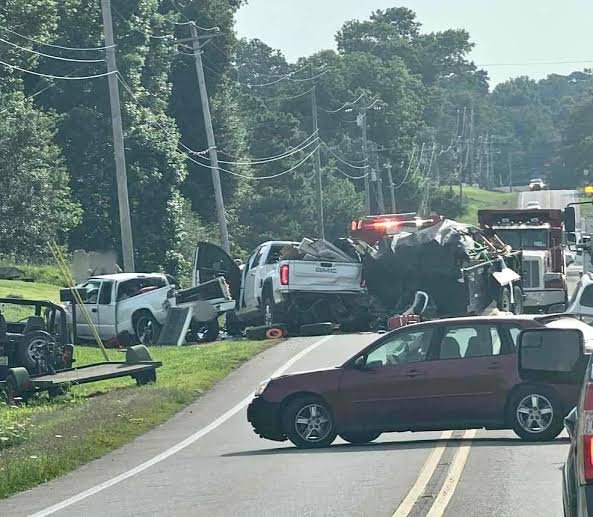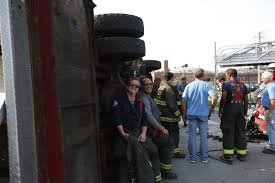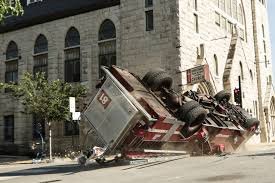
The tragic car accident involving members of the Chicago Fire Service occurred on a somber evening in mid-October 2023. The incident unfolded at approximately 7:45 PM at the intersection of Clark Street and Washington Boulevard, a location not typically associated with high accident rates. This accident claimed the lives of two dedicated firefighters, leaving a profound impact on their colleagues, families, and the broader community. As emergency responders, firefighters are often seen as the unsung heroes, and instances of loss within this profession resonate deeply with the public.
The car crash highlights key themes of tragedy and loss, underscoring how such unexpected events can alter lives in a matter of seconds. As first responders, these firefighters had spent years protecting the city of Chicago, putting their lives on the line to ensure the safety of its residents. The gravity of the situation was further compounded by the emotional and mental health implications for the remaining crew members, who were forced to confront the stark reality of the risks associated with their profession.
Moreover, this incident draws attention to the crucial importance of traffic safety for emergency vehicles. The sacrifice of these firefighters serves as a somber reminder of the dangers faced not only by emergency personnel but also by civilians navigating urban environments. In the wake of such tragedies, discussions surrounding preventive measures, safety protocols, and community awareness become increasingly relevant. This introduction sets the stage for a deeper exploration of the factors contributing to this heart-wrenching incident, as well as the ongoing impact arising from such unforeseen calamities.
Details of the Accident
The tragic accident involving the Chicago Fire Service occurred on a clear afternoon, with a timeline of events that paints a comprehensive picture of the moments leading up to the collision. On a typical weekday, emergency responders were en route to a reported gas leak, activating their sirens and lights as they navigated through the city’s streets. According to eyewitness accounts, the fire truck approached an intersection with caution, seemingly adhering to the regulations that govern emergency vehicle operations.
As the fire truck entered the intersection, a civilian vehicle traveling in the opposite direction failed to yield despite the visible signs of an emergency vehicle. Witnesses noted that the civilian driver appeared distracted, potentially due to the presence of passengers or mobile devices. The collision resulted in significant damage to both the fire truck and the civilian vehicle, with debris scattered across the road, exacerbating the chaos of the incident.
Weather conditions on the day of the accident were reported to be clear, with no precipitation or fog to hinder visibility. However, it was notably windy, which might have influenced other drivers’ decision-making processes at that time. The road was dry, and traffic was relatively light, allowing for quick responses from bystanders who witnessed the accident unfold. Emergency services arrived promptly at the scene, demonstrating the swift action prevalent in such urgent situations.
The aftermath of the accident left the community shaken, as it underscored the dangers that emergency responders frequently face on the roads. As investigations continue, understanding the dynamics of this incident is crucial in preventing similar occurrences in the future. Eyewitness testimonies and traffic camera footage will likely play essential roles in comprehensively assessing the circumstances surrounding this tragic event.
Impact on the Fire Service Community
The tragic accident involving the Chicago Fire Service has reverberated throughout the entire fire service community, highlighting both the emotional toll and operational ramifications for first responders. When a tragic incident occurs, it is not just the individuals directly involved who feel the weight of the loss; colleagues and fellow firefighters are deeply affected as they grapple with the grief of losing a peer. This shared sorrow can lead to significant emotional strain, manifesting in various ways, including anxiety, depression, and feelings of vulnerability among first responders.
In addition to the emotional impact, the accident has raised concerns about operational effectiveness within the fire department. The gravity of such incidents may lead to increased stress levels, which can hinder decision-making and reduce overall morale. Firefighters are trained to manage crises, but when they experience trauma themselves, it can be challenging to maintain the high standards required in emergency situations. Therefore, it becomes imperative for the fire service community to recognize the importance of mental health resources and support systems.
Establishing robust support networks for first responders is critical in mitigating the psychological aftermath of such accidents. Many fire departments have begun implementing peer support systems, where more experienced personnel assist their colleagues in dealing with grief and trauma. Counseling services tailored specifically for emergency service workers have become increasingly important. In addition, organizations dedicated to firefighter health and wellness provide training and resources to help department members cope with crisis situations and the intense emotions that follow.
As the Chicago Fire Service copes with the ramifications of this tragedy, it is essential to remember that addressing the emotional well-being of the firefighting community is just as crucial as ensuring their operational readiness. Supporting one another during these challenging times will ultimately strengthen resilience and foster a culture of care within the fire service.
Injuries and Medical Response
On the fateful day of the Chicago Fire Service accident, a total of 14 individuals sustained injuries, prompting an immediate response from emergency medical services (EMS). The nature of the injuries varied widely, with several individuals suffering from serious trauma, including fractures, soft tissue injuries, and contusions. In addition to physical injuries, some victims experienced psychological distress, necessitating prompt psychological assessments and support.
As soon as the incident occurred, local EMS teams were dispatched to the scene. The response was swift and coordinated, with multiple ambulances arriving within minutes to provide care and transportation to medical facilities. Paramedics, equipped with advanced training and medical equipment, quickly assessed the victims’ conditions. Their efforts were critical in stabilizing patients before they were transported to various hospitals across the city.
The medical professionals on-site utilized triage protocols effectively to prioritize care based on the severity of injuries. Quick thinking and decisive action were evident among the EMS personnel, who provided life-saving interventions, including the administration of oxygen and intravenous fluids. The heroic efforts of these medical responders underscored the importance of preparedness in dealing with mass casualty incidents.
Following initial care, the injured individuals required a range of treatments, including surgeries for more severe injuries. Hospitals mobilized their trauma teams, ensuring that specialized care was provided immediately upon arrival. Rehabilitation services would also be necessary for many of those injured, marking the beginning of a long journey towards recovery.
The collaborative response from medical teams exemplified the dedication and professionalism of emergency services in Chicago. Their commitment to serving the community extended beyond immediate care, paving the way for comprehensive support as victims began their recovery process after this tragic event.
Memorial and Tributes
The tragic accident involving the Chicago Fire Service has not only left a profound impact on the firefighting community but has also united the city in mourning. In the days following the incident, the residents of Chicago demonstrated their support for the victims and their families through various memorials and tributes. Public vigils were organized at numerous fire stations across the city, drawing together individuals from all walks of life who aimed to pay their respects. These events served as poignant reminders of the bravery exhibited by fire service members and the sacrifices they make in the line of duty.
City officials, including the mayor, released heartfelt statements urging citizens to remember the fallen heroes. They emphasized how the fire service stands as a pivotal force for safety within the community and that their dedication deserves recognition and reverence. The outpouring of support included not just official statements but also initiatives encouraging local businesses and community organizations to create their own tributes. Flowers, candles, and personal reflections could be found at various fire stations, illustrating a collective grief shared among community members.
Moreover, social media platforms played a significant role in sharing the community’s efforts to honor the victims. Hashtags celebrating the lives of those who fell on that fateful day served to encourage ongoing dialogue about the valiant efforts of the fire service. Many shared photographs and stories of their interactions with the fallen members, highlighting their commitment to serving others. These efforts underscored the resilience of the community in the face of tragedy, illustrating how the memory of these brave individuals will continue to inspire future generations. As the community reflects on their shared loss, it strives to foster a deeper appreciation for public service and the sacrifices that come with it.
Historical Context of Fire Service Accidents
The history of fire service accidents is a somber reminder of the inherent dangers faced by firefighters in the line of duty. Over the decades, firefighting has evolved from a largely unregulated and hazardous profession to one that emphasizes safety and preventive measures. Historically, fire service accidents were distressingly common, with a multitude of factors contributing to tragic outcomes. According to historical data, fire departments have recorded thousands of firefighter fatalities and injuries as a result of operational challenges and inadequate safety protocols.
In examining the common causes of these accidents, several recurring themes emerge. Structural collapses, vehicular accidents during responses, and exposure to hazardous materials are among the most prevalent factors leading to firefighter injuries and fatalities. For instance, before the implementation of modern safety gear and protocols, firefighters often faced life-threatening conditions without appropriate protective equipment, significantly increasing the likelihood of accidents. Fire departments were often ill-equipped, lacking the necessary resources and training to effectively manage challenging situations.
Over the years, the fire service industry has recognized the critical need for reform, prompting a concerted effort to enhance safety measures through the establishment of comprehensive training programs and the introduction of stringent regulations. The National Fire Protection Association (NFPA) has played a vital role in developing standards that promote firefighter safety, addressing everything from the use of personal protective equipment to emergency response strategies. As a result of these ongoing efforts, statistics demonstrate a marked decline in fatalities and accidents in more recent years, illustrating significant advancements in the industry’s approach to safety.
Reflecting on the historical context of fire service accidents is essential, as it allows not only for an understanding of the past but also informs ongoing improvements in practices and protocols, ensuring that the brave individuals who dedicate their lives to protecting the community are afforded the safest possible working environment.
Legal and Safety Implications
The recent Chicago Fire Service accident has raised significant legal and safety concerns that warrant thorough examination. Following such incidents, it is common for extensive investigations to unfold, primarily focused on identifying the underlying causes and determining accountability. Law enforcement agencies, in collaboration with fire department officials, typically conduct inquiries to ascertain if negligence or violations of safety protocols contributed to the accident. Depending on the findings, potential legal ramifications may include civil suits filed by affected parties or even criminal charges against individuals deemed responsible for lapses in safety adherence.
Moreover, the implications extend beyond immediate legal accountability; they serve as a catalyst for broader systemic change. The investigation process can illuminate specific deficiencies in safety practices within the fire service or reveal failures in organizational protocols. In previous cases, such reflections have led to renewed discussions about training, equipment, and response strategies designed to protect firefighters and the public from future accidents. Legal outcomes can compel organizations to implement significantly enhanced safety measures, ensuring compliance with industry standards and protecting both first responders and civilians alike.
Recommendations for improving safety often include the adoption of advanced training programs that emphasize situational awareness and emergency response protocols. Additionally, a review and upgrading of existing safety equipment can mitigate risks. Fire departments may consider incorporating technology that enhances communication between team members during emergency situations. Collaboration with regulatory bodies can also play a vital role in establishing more stringent safety guidelines and protocols. Ultimately, the Chicago Fire Service accident serves as a somber reminder of the necessity for comprehensive safety frameworks, aimed at preventing future tragedies and ensuring that those who serve do so in a safer environment.
Community Response and Support Initiatives
The Chicago Fire Service accident not only shocked the affected families but also sent ripples throughout the local community, which has since displayed a remarkable sense of solidarity and compassion. In the wake of this tragic event, numerous support initiatives have been launched aimed at honoring the victims and providing assistance to those directly impacted by the incident. Residents, local organizations, and businesses have come together, demonstrating the strength and resilience of the community.
Fundraising efforts have become a focal point in the community’s response. Various local charities and organizations have mobilized to create events designed to raise financial support for the victims’ families. For instance, community-led vigils and charity runs have attracted participation from a diverse array of individuals, all coming together to show their support. These events not only serve as a means to gather funds but also provide a platform for healing and remembrance, enabling community members to express their grief while simultaneously supporting one another.
In addition to fundraising, several local businesses have pledged to donate a percentage of their sales to support the families affected by the accident. This initiative has encouraged residents to shop locally, fostering a sense of unity and prompting them to contribute to causes that resonate with them. Furthermore, gatherings like community meals have organized to create networks of support, allowing families to share their experiences and challenges in a safe environment.
The outpouring of kindness and empathy has been overwhelming, reflecting the community’s commitment to standing together during difficult times. Local leaders have also played a role in coordinating these efforts, ensuring that resources are properly allocated to those most in need. Through these initiatives, the community is not only honoring the victims but also reinforcing the bonds that unite them in times of despair. In conclusion, the response of the Chicago community serves as a powerful reminder of the strength found in solidarity and support amidst tragedy.
Conclusion and Moving Forward
Reflecting on the tragic accident involving the Chicago Fire Service, it is imperative to recognize the profound impact this event has had on the community, emergency services, and the city of Chicago as a whole. Throughout this review, we have examined the circumstances surrounding the accident, the immediate responses from various sectors of the community, and the conversations it has sparked regarding safety, emergency protocol, and the essential role of first responders.
The loss of lives in this incident serves as a stark reminder of the dangers faced by those in the fire service. It highlights the necessity for continuous training, updated safety measures, and robust support systems for first responders. This tragedy has ignited a commitment to ensuring that such situations are better managed in the future, thus protecting the brave individuals who confront dangers on our behalf.
As the community rallies together to support the families affected by this incident, it is vital to foster environments that prioritize mental health and resilience among fire service personnel. The city of Chicago, along with involved agencies, must now focus on developing strategies that not only honor the sacrifices made but also enhance operational protocols to prevent future occurrences. This includes reviewing existing policies, investing in modern technology, and promoting a culture of accountability and teamwork.
Moreover, engaging the public in conversations about emergency preparedness and awareness will fortify the relationship between the fire service and the communities they serve. By learning from this tragedy, we can cultivate a resilient spirit that embraces collective growth and honors the legacy of those lost. Moving forward, we must ensure that the lessons learned transcend this tragedy, ushering in a safer future for the Chicago Fire Service and the people they protect.





